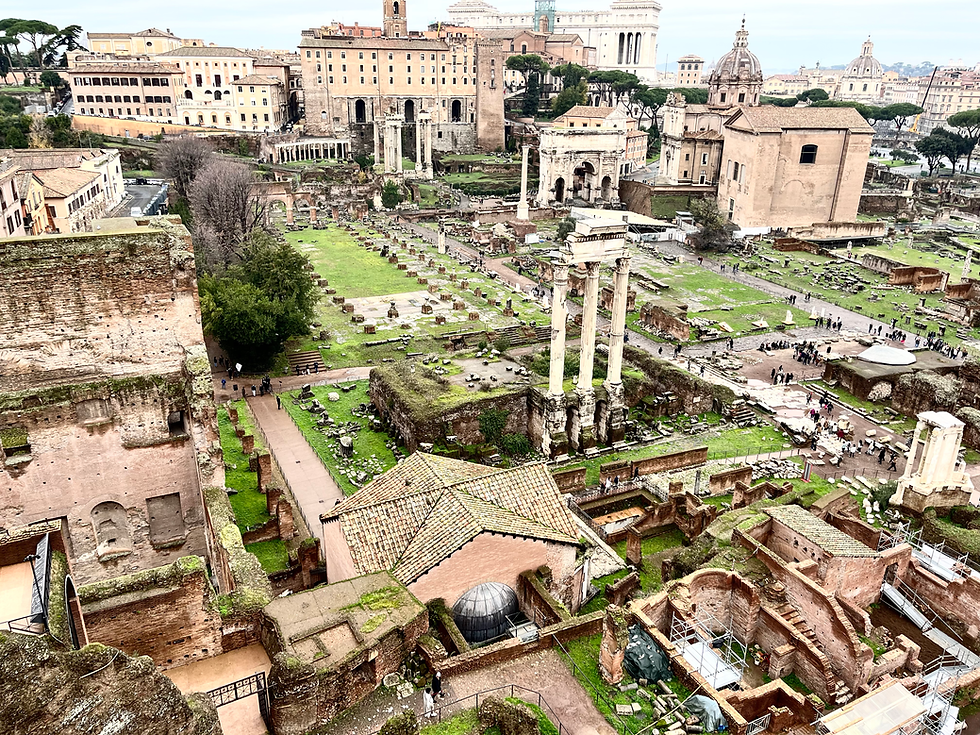Why Rome is in Ruins
- charlsiedoan
- Dec 25, 2022
- 3 min read
Updated: Aug 21, 2023

I took Latin for six years; none of the language stayed with me, but I still remember the stories and a bit about Roman history and culture. So, when I was planning to head to Italy, I knew that Rome had to be on the agenda. All the verb conjugating and translating of tombstones had to be worth something!
And it was! Rome is a stressful place, filled with crazy traffic, cigarette butts, and street hawkers asking you, way too eagerly, what your name is and if you're enjoying your time in Italy. But it also felt a little bit like coming home, to the place where so many great storytellers, thinkers, and leaders walked, to the place I'd read about and learned about for years. Rome was arguably the beginning of the modern conception of the West and of the institution of Christianity, the institutions that anchor the United States. So of course Rome felt familiar.
And, of course, there is so much to see in Rome. The city is called a “historical lasagna” because it is built on layers upon layers of ruins. Just like we demolish old buildings to build new ones, generations of Romans tore things down and built new things on top of the rubble. Imperial Rome built on top of Republican Rome, Christian Rome built on top of Imperial Rome, then the Vatican built on top of Christian Rome. Rome doesn’t have a good subway system because it’s impossible to dig tunnels through the city center without destroying something super old with great historical importance. When you visit the Roman Forum, it’s at a significantly lower elevation than the rest of the city because archeologists had to dig so far down to find it (destroying a lot of other history in the process, but they really wanted to get down to the time of Augustus and so didn’t think things through).

Not everything was destroyed; there is a lot in Rome that has stood for almost 2,000 years. The Colosseum is an obvious example, although it is falling apart. It was known in its time as simply the Amphitheater or the Flavian Amphitheater (because it was built by emperors from the Flavian dynasty, the second family to rule imperial Rome), and it hosted animal hunts, executions, and gladiatorial events. My guide during my Colosseum tour mentioned the movie Gladiator about ten times. It was sanctified a couple hundred years ago by one of the popes, supposedly to honor all the Christian martyrs who died in the arena, but in reality most probably died elsewhere. Even so, the Colosseum is now part of the Vatican’s Easter celebrations.
The Colosseum is falling apart for two reasons: first, the higher levels of seating were built with progressively lighter and therefore weaker material so that the building didn’t collapse in on itself. The pumice, wood, and brick didn’t withstand the elements well and deteriorated. The second reason is a little bit unexpected: people stole lead, bronze, and stone from the Colosseum’s structure to use for other projects or to sell. This happened to lots of the buildings in Rome; sometimes it was just average people, but sometimes it was on the order of the Pope at the time. In Rome’s poorer years, there wasn’t money to requisition new materials, but the emperors and popes still needed to build things to satisfy their giant egos (all three of my guides in Rome talked about this; almost everything cool in Rome was built by an emperor or a pope to show off their power and/or wealth).

However, if a building was sanctified, it was less likely to be picked over, especially by the common people. This is why the Pantheon, a temple older than the Colosseum, is still in great condition despite being packed with precious marble and metals. Today the Pantheon is a church and home to the tombs of the first and second kings of unified Italy and the artist Raphael. But sanctification couldn't protect buildings from the church itself--the bronze from the roof of the Pantheon was requisitioned by a pope and used by Bernini to built the massive marble canopy that sits over the altar in St. Peter's Basilica.
Comentarios